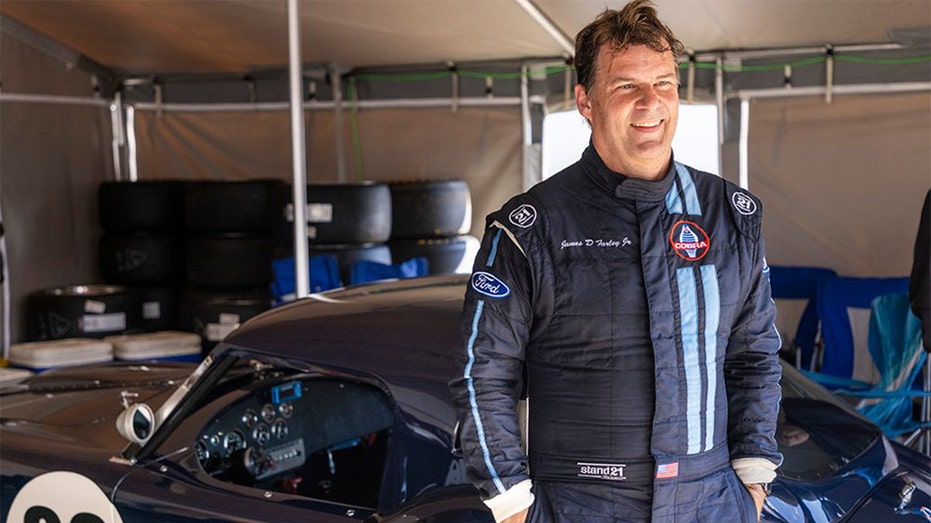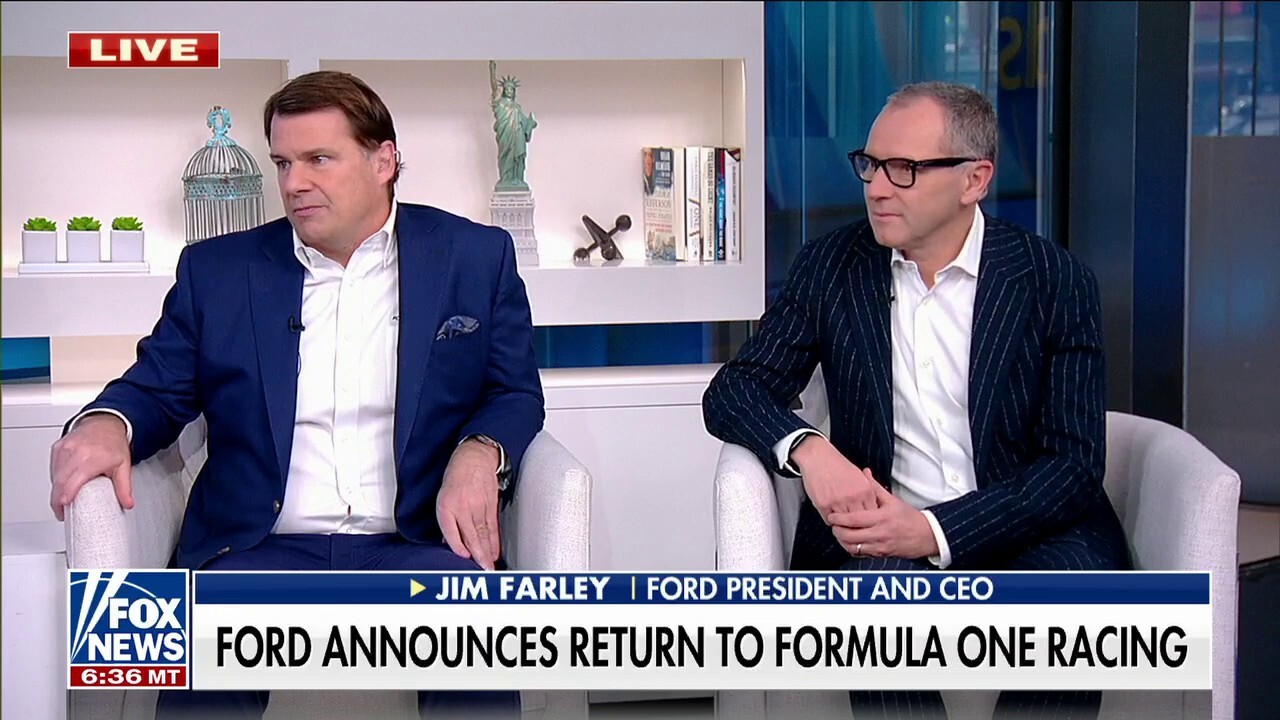Ford CEO Jim Farley grapples with problems from the auto maker’s past
Executives say Ford’s traditional business has proved more difficult to transform than expected
Ford announces return to Formula 1 racing
Ford President and CEO Jim Farley and Formula 1 CEO Stefano Domernicali discuss Ford's growth in the auto industry and employment and announce its return to Formula 1 racing.
Jim Farley took over Ford Motor Co. more than two years ago, eager to chart the auto maker’s path to an electric, high-tech future. Lately, though, problems from the past are requiring his attention.
In recent weeks, Ford executives have outlined many challenges holding the company back: Ford still has too many people, Mr. Farley has said, even after cutting 3,000 jobs last year, and outlining plans this week for another 3,800 cuts in Europe.
Ford’s factories too often churn out vehicles of subpar quality, and supply-chain management lags behind competitors, executives said.

An F-150 Lighting pickup truck line at Ford’s Dearborn plant. Ford’s gas- and diesel-engine-vehicles business account for more than 95% of U.S. sales with EVs currently less than 5% of sales. (Ford / Fox News)
And overall, Ford’s annual costs are $7 billion to $8 billion too high relative to rival auto makers, according to its finance chief.
FORD VS. GM: A TALE OF TWO AUTOMAKERS
"We have deeply entrenched issues in our industrial system that have proven tough to root out," Mr. Farley said earlier this month on the company’s fourth-quarter earnings call.
Mr. Farley has pointed to the irony that Ford—which invented the moving assembly line and built an industrial system that was the marvel of the world early last century—is being tripped up by some basic nuts and bolts of the car business.

CEO Jim Farley says his main focus is implementing cultural changes that will make Ford more efficient. (Ford / Fox News)
"This is what we should be known for. It is our legacy," Mr. Farley said.
On Wednesday, Ford said a battery fire in an F-150 Lightning was the reason it halted production at the Detroit-area factory that makes the electric pickup truck. Ford said the plant will be down at least through the end of next week as it investigates the cause and said it doesn’t think trucks shipped to customers are affected by the problem.
FORD’S RISING EV SALES CONTRIBUTE TO BIGGER MARKET SHARE
Previous Ford CEOs also have cited deep-rooted problems in Ford’s industrial system, which have lingered following different company overhauls through the years.
Former CEO Alan Mulally, who led the auto maker for nearly eight years before his 2014 retirement and was lauded for revitalizing the company, complained of needless complexity. Mr. Farley’s predecessor, Jim Hackett, who took over in 2017, emphasized the need for better operational fitness while cutting thousands of jobs.
"Clearly there were costs that were never taken out, or they were taken out and then put back in," Morningstar analyst David Whiston said. "That is frustrating for investors, I’m sure."
Ford’s shares have lagged behind competitors this year, increasing about 11% since the start of the year, compared with General Motors Co.’s 28% increase and a 20% rise for Jeep maker Stellantis NV. Ford’s stock performance during the past 12 months also trails those rivals.
| Ticker | Security | Last | Change | Change % |
|---|---|---|---|---|
| F | FORD MOTOR CO. | 13.31 | -0.36 | -2.63% |
| GM | GENERAL MOTORS CO. | 81.34 | +0.83 | +1.04% |
| STLA | STELLANTIS NV | 11.65 | -0.01 | -0.13% |
Ford is faced with fixing entrenched industrial problems while also moving the company to a future tied to electric vehicles and digital services. It is a task confronting other global auto makers as they try to balance improving their legacy operations with building new business models.
"We have to do it all concurrently," Ford Executive Chairman William Clay Ford Jr. told reporters Monday.
The troubles were evident in Ford’s fourth-quarter financial results, which fell short of its forecast, sending shares tumbling. Ford’s adjusted pretax earnings for 2022 of $10.4 billion were well below that of GM, which posted $14.5 billion for the year.
GM RETAKES TOP SALES SPOT FROM TOYOTA WITH STRONG 2022 FINISH
GM out-earned its rival last year on slightly less revenue and fewer workers. Ford has about 173,000 workers globally, compared with GM’s 167,000, according to regulatory filings. GM also sold more vehicles last year—about 5.9 million, compared with Ford’s 4.2 million.
Mr. Farley’s main focus is implementing cultural changes that will make Ford more efficient, he said at an analyst conference Wednesday.
"Quality and cost can be solved by the same approach: to go into the company and literally change the behaviors on how we engineer something, how we source it and how we build it," Mr. Farley said.
The problems in Ford’s core operations threaten to hinder Mr. Farley’s goal for Ford to emerge as a top producer of EVs, analysts say. Ford’s gas- and diesel-engine-vehicles business account for more than 95% of U.S. sales and virtually all of the company’s profit, generating cash needed to underwrite the move to electric and increasingly digital vehicles.

Ford employees celebrate the completion of the 150,000th Mustang Mach-E (Ford / Fox News)
In public appearances, Mr. Farley often contrasts Ford to electric-vehicle leader Tesla Inc. He cites areas where Ford is lagging behind, and he has cited Tesla’s more than $10,000-per-vehicle cost advantage, a gap that he’s trying to erase at Ford.
The CEO also has set a goal of eventually surpassing Elon Musk’s company in U.S. sales, and has been recruiting talent from Tesla, Apple Inc. and other tech companies to help Ford navigate the hurdles inherent in switching over to EVs.
| Ticker | Security | Last | Change | Change % |
|---|---|---|---|---|
| TSLA | TESLA INC. | 467.26 | -22.62 | -4.62% |
Ford executives have cited a need to reduce complexity across the company. Mr. Farley has said the car maker needs to offer fewer models and simplify customer choice from what can be an array of feature packages and build combinations.
TESLA WAS THE USA'S BEST SELLING LUXURY CAR BRAND IN 2022, BEATING BMW AND MERCEDES-BENZ
For example, Ford offers 57 options on its Explorer SUV, one of its top-selling models, compared with 24 options offered on the similarly sized Kia Telluride, according to a review from research site Edmunds at the request of The Wall Street Journal. Ford offers three powertrain choices for its Explorer, compared with one for the Telluride.
That complexity sometimes makes it more difficult for consumers to pinpoint a vehicle with the combination of features they want, said Edmunds analyst Ivan Drury. The additional options lead dealers to order a broader variety, which can result in inflated inventory and increase costs across Ford’s system, he said.
"In some instances dealers have to order vehicles with oddball sets of options and trim combinations as a ‘just-in-case,’" he said.
CLICK HERE TO GET THE FOX BUSINESS APP
Mr. Farley pledged to tackle Ford’s quality concerns when he took on the role of chief executive in late 2020. In the years since, the company has continued to struggle with high warranty costs, and last year racked up the most product recalls of any major auto maker for a second straight year, he said.
The company has started to see improvement after hiring a new executive director of quality and implementing more-rigorous preproduction checks, Mr. Farley said to analysts earlier this month. He said more changes are coming.
"We have spent the last several months really getting deep on where we need to go," he said.




















